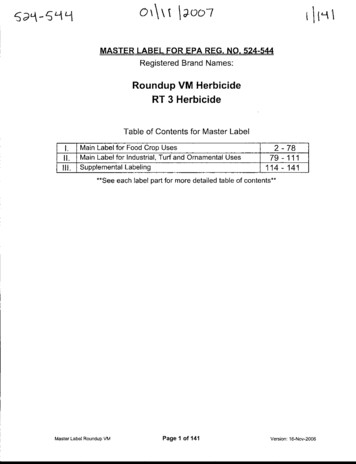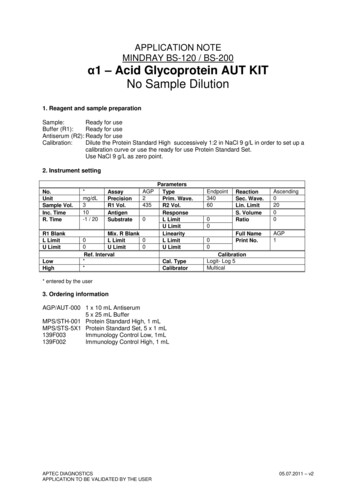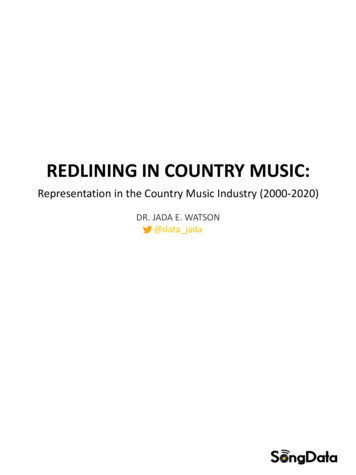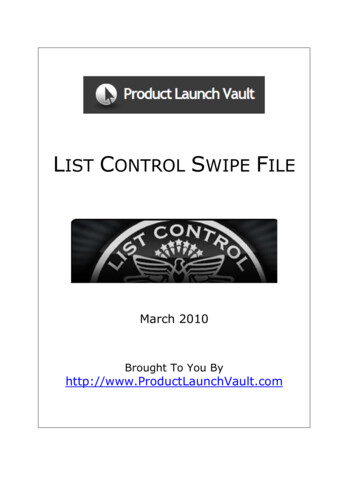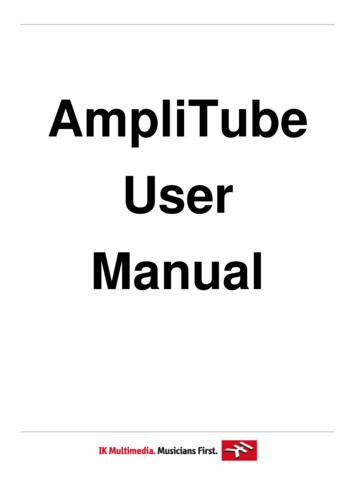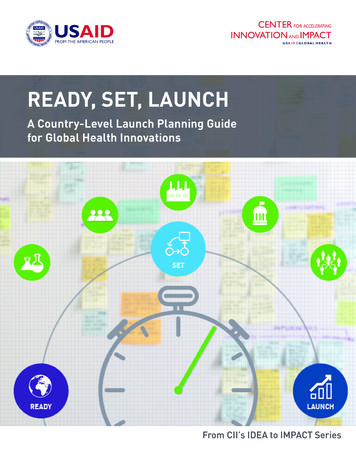
Transcription
READY, SET, LAUNCHA Country-Level Launch Planning Guidefor Global Health InnovationsFrom CII’s IDEA to IMPACT Series
USAID’s Center for Accelerating Innovation and Impact (CII) applies business-mindedapproaches to the development, introduction, and scale-up of health interventions to accelerateimpact against the world’s most important health challenges. Applying these forward-lookingpractices to USAID’s health investments, CII invests seed capital in the most promising ideasand cuts the time it takes to transform discoveries in the lab to impact on the ground.Ready, Set, Launch aims to support strategic and targeted planning for the introduction andscale of global health innovations, with a sharp focus on employing methods that fit thelocal context of the communities in which we work. USAID would like to thank our team ofexternal advisors and reviewers, many of whom are referenced throughout the Guide, forproviding valuable input. We are especially thankful to Dalberg Global Development Advisorsfor their partnership in developing this work. Questions and comments are welcome andcan be directed to the USAID leads for this Guide, David Milestone and Nikki Tyler.For contact information and to download the latest version of Ready, Set, Launchand CII’s library of Guides and tools, please visit www.usaid.gov/cii.
ForewordUSAID’s Center for Accelerating Innovation and Impact (CII) was founded to both catalyze newglobal health innovations and address the roadblocks to rapidly developing and scaling them up.To address these challenges, we not only apply cutting-edge practices to our own work but alsocollect and share these best practices with the broader global health community.We began sharing guidance and tools for scaling global health innovations a few years ago throughour publication, Idea to Impact. This work brought together delivery-focused priority activities andpractical tools at each stage of the product development process to ensure successful launch andscale. Our second companion piece in this Idea to Impact series, Pathways to Scale, provided earlystage innovators with a framework and tools to support business model design and partnershipevaluation at critical points along their scaling journey. We have been thrilled with the response,especially the examples of how this work has been put into practice.Now, with Ready, Set, Launch: A Country-Level Launch Planning Guide for Global Health Innovations,we look to complement the existing library of planning support with a companion piece targetedtowards country-level launch planning. This work focuses on the critical pivot as you move fromearly user testing, product design, and building out your organization to actual country selectionand planning for launch.Whether you are asking “what is the right set of countries for my team and product to launch innext?” or “how do I assess and prioritize the highest value country-level interventions to achievethe greatest level of impact and scale?”—there is no shortage of considerations as you move towardimplementation. This Guide addresses the complexity of product introduction by providing a simpleframework and practical tools to support innovators and practitioners in 1) prioritizing countriesfor launch, 2) developing a country-specific strategy, and 3) converting this strategy into an operationallaunch plan—one that creates accountability, sets targets, is actionable, and is carefully budgeted.With this latest addition to our Idea to Impact series, we’re proud to continue offering demanddriven public goods to help entrepreneurs, implementing partners, and even donors accelerateimpact by improving how they plan for the introduction of health innovations. As with all our work,we encourage you to put this Guide to the test and give us feedback so we can continue building,adapting, and sharing our collective learning.We look forward to hearing from you.Wendy TaylorDirector, Center for Accelerating Innovation and ImpactGlobal Health Bureau/USAID
CONTENTS01Introduction03 When to use this Guide05 Who can use this Guide06 How this Guide fits together07The Ready, Set, Launch Framework08 Guiding principles09 Core components of scale-up11Step 1: Ready? Select a GeographyPrioritize an appropriate country (or set of countries) for scale-up, based onthe vision for the product and market realities at hand13 Step 1.1: Shortlist countries for launch15 Step 1.2: Finalize country selection20 Vignette: Strategic country selectionLessons from Medicines360 & the LNG-IUS21Step 2: Set.Build a StrategyAssess the chosen market in depth in an effort to identify barriers to scale andaddress those barriers with thoughtfully designed interventions23 Step 2.1: Assess market and barriers to scale34 Vignette: The importance of early and frequent stakeholder engagementLessons from the Elizabeth Glaser Pediatric AIDS Foundation (EGPAF)35 Step 2.2: Develop strategy for overcoming barriers to scale-up38 Vignette: Identifying and breaking down barriers to scaleLessons from Novartis Accessiv
39Step 3: Launch! Plan for Scale-UpDevelop a detailed operational launch plan to guide day-to-day activities,set realistic uptake targets, and create a plan to monitor progress41 Step 3.1: Develop operational launch plan43 Vignette: Integrating a new product into a community health systemLessons from Medicines for Malaria Venture (MMV)45 Step 3.2: Set uptake targets and create monitoring plan47 Vignette: The importance of prioritizing interventions in an operational launch planLessons from the Strengthening Health Outcomes through the Private Sector (SHOPS)Ghana Project49Case Studies51 Case Study 1: Development of national strategy and operational launch plan forchlorhexidine in Nigeria55 Case Study 2: Introduction of Xpert MTB/RIF in Indonesia59 Case Study 3: Scaling Gradian Health’s anesthesia machine in Uganda63Appendix6364656768AcknowledgmentsSummary of tools in Ready, Set, LaunchProduct-specific scale-up challengesAdditional resources and referencesCountry Launch Canvasv
INTRODUCTIONGlobal health practitioners know that introducing andscaling new innovations is a complex process. There isno shortage of factors to consider when developing aproduct and delivering it to the world’s hardest to reachpopulations—from defining the problem and productrequirements to evaluating market feasibility to developingand executing an operational launch plan. As a result,global health innovations often take decades to reachintended users at scale; at times, the innovation neverreaches anywhere near global coverage targets (Figure 1).This is in contrast to “typical” launches in the United Statesand other high-income countries, which often reach theirfull coverage targets in less than five years.To accelerate the impact and scale of global healthinnovations, lessons can be learned from the principlesthat pharmaceutical and medical technology companiesuse to coordinate and plan for market introductionand expansion. CII developed the predecessor to thisdocument, Idea to Impact: A Guide to Introduction andScale of Global Health Innovations, with these principlesof pharmaceutical and medical technology companies inmind. To support the product development process, Ideato Impact provides structure and practical tools from earlyproduct design through launch for those planning to reachglobal scale. Early-stage entrepreneurs, pharmaceuticaland medical device companies, graduate students,Figure 1. Years to scale-upGlobal coverage (%)100%(date) launch yearDRUG(Avg. HIC)VACCINE(Avg. HIC)Hepatitis BVaccineDIAGNOSTIC(Avg. HIC)(1981)75%ORS(1977)50%Hib Vaccine(1987)ARVsACTs(1987 LMIC)(1999)25%RotavirusVaccine(2006)0%051020ACT: Artemisinin-based combination therapyARV: AntiretroviralHib: Haemophilus influenza type bHIC: High-income countriesLMIC: Lower- and middle-income countriesORS: Oral rehydration solutionSource: Bill & Melinda Gates Foundation115Years from launch3025
This complementary Guide, Ready, Set, Launch: A Country-LevelLaunch Planning Guide for Global Health Innovations brings asharp focus to the critical pivot from global product developmentto targeted country selection and launch planning.NGOs, donors, implementing partners, and ministries ofhealth alike have all seen the role that more deliberateand earlier delivery planning can play in accelerating theimpact of life-saving innovations.Achieving sustainable impact and scale, however,requires practitioners who think globally to act locally.This includes understanding and addressing the manycountry-level factors, including existing user behaviors,local regulatory requirements, supply chains, key opinionleaders, and local religious and cultural norms thatcan vary within a country, state, county, or village. Thiscomplementary Guide, Ready, Set, Launch: A CountryLevel Launch Planning Guide for Global Health InnovationsReady, Set, Launch does Help practitioners select a country forproduct launch and/or determine whetherthey should scale a product in a specificcountry Develop a plan for country-level scale-up ofproducts Tailor launch approaches to specificcountries and products Learn from practical examples and applytoolsbrings a sharp focus to the critical pivot from globalproduct development to targeted country selection andlaunch planning.With input from a diverse set of practitioners and lessonsgathered from both successful and not-so-successfullaunches, Ready, Set, Launch brings together guidance,tools, and case studies to support country prioritizationand the development of a comprehensive scale-upstrategy and launch plan. While there is no simple formulaor one-size-fits-all solution, this Guide aims to providepractitioners with a set of key questions and a moresystematic approach to launch and scale-up.Ready, Set, Launch does not Help practitioners develop new global healthproducts Test new products without any existing datafrom clinical trials and/or proof of concept Gather information specific to one country orgeography or specific to one product or typeof products Access a ready-made scale-up strategy2
INTRODUCTIONCONTENTSWhen to use this GuideReady, Set, Launch takes a deeper dive into many of theactivities outlined in Stage 3 of Idea to Impact—with asharp focus on country-level launch planning. This Guideassumes that practitioners have spent significant time(sometimes years) addressing the many related productdevelopment and delivery activities completed beforeStage 3. For this Guide to be useful, practitioners shouldhave a product that is cost-effective, has demonstratedclinical efficacy (although local clinical evidence orproduct modifications may be necessary) and havealready developed a global situation assessment asper Stages 1 and 2 of Idea to Impact—for example,by defining the product’s global vision and valueproposition, understanding the global market feasibilityand opportunity, ensuring that the product meets WHOand other global guidelines and standards, etc. However,planning for country-level launch can occur in parallelwith some of the above activities, especially for thosethat take time (e.g., updating guidelines, obtainingclinical evidence).Lessons learned from using this Guide can—and should—inform the overall development and delivery planningprocesses by providing new insights that can help shapeboth the global strategy and the country-level launchplanning.You can also read Ready, Set, Launch along with itscompanion Guide, Pathways to Scale, which supportsglobal health innovators in the early stages of productdevelopment as they consider their particular businessmodel and partnership options. An innovator with atechnically viable product could be following Ready, Set,Launch to develop plans for country launch and scale-up,while at the same time, using Pathways to Scale to weighshort and long-term strategic options for business modeland partnership decisions.Figure 2 provides guidance on the primary focus of eachpublication, its target audience, and the ideal point inproduct development cycle for a practitioner to consult it.An overarching global vision for the product should alwaysremain top of mind. It drives purpose and alignmentwith necessary country-specific strategies.Jeffrey Jacobs, Merck for MothersSome of the first questions I ask about a global healthinnovation is if there is an evidence-base for its health impactand if the innovation fits with global strategy. These questionsare important for generating buy-in at the global level—withorganizations such as the WHO—but also at the country level.Lily Kak, USAID, Maternal and Child Health3
Figure 2. The IDEA to IMPACT SeriesIDEA TO IMPACTPurpose: Identifies priorityactivities and providesproject managementoversight across fourstages of the productdevelopment continuumto help practitioners thinkthrough, plan, and executeon delivery-related activitiesTarget Audience: Social entrepreneurs,innovators, implementers, and funders who aredeveloping a global health innovationPATHWAYS TO SCALEPurpose: Providesorganizational guidancefor innovators inselecting the mostrelevant business modeland partnership optionsto be able to scaleTarget Audience: Social entrepreneurs andinnovators building an organization and/orpartnering in preparation for launch and scaleREADY, SET, LAUNCHPurpose: Supportspractitioners inselecting initial launchcountry(ies) and creatinga comprehensive strategyand operational launch planto achieve scaleTarget Audience: Social entrepreneurs,innovators, implementers, and funders readyto pivot from product development to actualintroduction into a given geographyUSAID’s Center for Accelerating Innovation and Impact (CII’s) IDEA to IMPACT series sharesguidance for scaling global health innovations. Through case studies and tools, this series outlinesdelivery-focused priority activities at each stage of the product development process, provides aframework and tools to support business model design and partnership evaluation, and supportscountry-level planning for launch.4
INTRODUCTIONCONTENTSINTRODUCTIONWho can use this GuideThree audiences stand to benefit most directly from Ready, Set, Launch:Innovators, broadly defined, are organizations—either non-profit or for-profit—Innovatorsthat have successfully developed and tested a product and are now looking to scale.Innovators are often resource constrained, and their expertise is generally concentratedin technical product development rather than in understanding and influencing markets.In many cases, innovators are trying to balance their desire for health impact withconcerns around financial sustainability. They want to drive impact and sales—fast.Implementers include both public sector agencies and large non-profits that specializeImplementersin healthcare delivery and house significant global health expertise. These actorsoften have an established presence in countries of interest and their primary focus isimpact and long-term uptake. Non-profit implementers often work on project-specificcycles that support multiple products at once. Implementers generally have strongrelationships with local stakeholders, importantly governments, as a result of years ofwork in a given country.Donors are development agencies, public and private financial institutions, andDonors5philanthropic entities that fund the activities of innovators and implementers. Donorsare especially concerned with tracking the impact of their dollars. As such, they maywant to use this Guide to ensure that grantees have a plan in place to achieve scale, andthen monitor the scale-up efforts of their grantees to ensure that steps are taken towardachieving impact at scale. Depending on whether a practitioner is an innovator, implementer, donor, or other global healthpractitioner, the activities described here may prove easier or harder to take on. For example,innovators worried about sustaining their venture through scale-up will likely find challengesrelated to creating sustainable business models or generating funding much more salient thanimplementers who are adopting an innovation or donors who are funding one. In addition, different practitioners will face their own internal challenges depending on their skills,resources, and networks within a country; it is important to take these unique limitations intoaccount when moving through this Guide. More importantly, focusing on the areas where theselimitations exist is critical, even if these limitations are more difficult to address. A comprehensivelaunch and scale-up strategy needs to account for such limitations rather than ignore or overlookthem and risk allowing important tasks to slip through the cracks.
Apart from these three audiences, Ready, Set, Launch can also inform other global health practitioners, includingresearch institutions and laboratories that develop new products, civil society organizations that support healthcaredelivery, and large for-profits (e.g., pharmaceutical and medical technology companies) interested in expandingproduct reach into emerging markets. This Guide can also be used as a teaching tool for academic institutionsinforming future global health and business leaders how to approach introduction and scale.Ready, Set, Launch is primarily geared toward drugs, devices, and diagnostics. However, the principles discussed andthe activities and tools included can be applied to other global health innovations as well, including vaccines, healthbehaviors, direct-to-consumer products, service delivery systems, and health equipment/infrastructure.How this Guide fits togetherThis Guide is made up of two parts:Ready, Set, LaunchReady, Set, Launch provides high-level guidance through three steps: 1) countryprioritization, 2) strategy development, and 3) implementation planning. Foreach of these three steps, the Guide outlines key questions to consider, providesexercises (with approximate estimates of the time to complete), and suggeststools to help answer those key questions. It offers real-world examples throughboth short vignettes and more comprehensive case studies that highlightlessons relevant to the launch planning process.Supplemental ToolkitThe Supplemental Toolkit, available on CII’s website, is a collection of tools andtemplates highlighted in the Guide that can provide structure, inspiration, andpractical guidance for the launch planning process. To help see how these toolsmight be used in practice, this Guide contains illustrative, pre-populated toolsbased on the development of an operational launch plan for chlorhexidine (CHX)in Nigeria. See page 51 for more details.We have also included a fold-out “Country Launch Canvas” which provides acomposite of all of the key elements of a scaling strategy in one place. It canserve as a brainstorming tool to help practitioners think through many of theprinciples described in this Guide and to highlight key learnings and activitiesof a given launch plan. For those downloading this Guide, the Country LaunchCanvas can be found in the Supplemental Toolkit. See page 68 in the appendixfor more details on the Country Launch Canvas.It should be noted that activities described are suggested steps for those who want to follow a “play book.”They are only one way of doing things, but not the only way. It is more important to strive to answer the keyquestions posed in the Guide rather than to strictly follow the sequence of activities.As this Guide will be continually updated with new thinking, case studies, and tools, we encourage input or suggestions.Contact information along with the latest version of the Guide and toolkit can be found at www.usaid.gov/cii.6
THE READY,CONTENTSSET, LAUNCH FRAMEWORKReady? Select a GeographyPrioritize an appropriate country (or set of countries) for scale-up, based onthe vision for the product and market realities at hand.Set Build a StrategyAssess the chosen market in depth in an effort to identify barriers to scale andaddress those barriers with thoughtfully designed interventions.Launch! Plan for Scale-UpDevelop a detailed operational launch plan to guide day-to-day activities,set realistic uptake targets, and create a plan to monitor progress.7
Guiding principlesFour key principles should guide country-level launch planning in order to ensure that resourcesdedicated to scale-up are used wisely and that the process stays on track. Leadership alongside partnershipSuccessful launch planning requires a leader—a single entity responsible for coordinatingscale-up of the product every step of the way. At the same time, a launch cannot succeedwithout partners—particularly those within the government and local ministry of health—supporting specific aspects of the process and advocating for the resources needed to pushscale-up along. IntegrationAny scale-up strategy should seek to support a country’s stated health priorities and tointegrate into ongoing health systems (potentially both public and private, depending on therelevant channels in the country and of the product) in order to leverage existing infrastructureand avoid creating parallel programs. Ensuring that the product is integrated into existinghealth priorities and systems will increase the likelihood of a successful launch. Re-evaluation and iterationAs they learn more, practitioners should continuously revisit both the decision to scale and theactivities associated with scaling. Scale-up is far from a linear process with clear milestones—there are bound to be failures that will require backtracking, changing plans, and trying again.Practitioners can use what they learn from these experiences to pivot the product, strategy,and operational launch plan. SustainabilityA country-level scale-up strategy should fit into an already established global pathway to scalefor the product—whether that strategy is to grow through partnerships, a multi-stakeholderpartnership, or a licensing deal. The launch plan should include a clear understanding of howthe product will be financed (public market) or generate revenue (public and/or private market)over the long-term.8
THE READY,CONTENTSSET, LAUNCH FRAMEWORKCore components of scale-upDuring product introduction, there are five inter-connected core components of scale-up that require continuousevaluation and action on the part of practitioners. A failure to address an urgent need within one core component couldput the entire scale-up effort at risk. During the country-level launch planning process, the questions below can serveas a reference to better understand the market and ensure launch planning is on track. Note also that for each corecomponent of scale-up, a summary of product-specific scale-up barriers for drugs, devices, and diagnostics can befound in the appendix.CoreComponentsMARKET AND USER1. Ready?Select a Geography What signs can provide information about userdemand (e.g., extremely low willingness to pay,market saturated with high-quality alternatives)? Are production/pricing economics viable for themarket?MANUFACTURINGAND DISTRIBUTION Is intellectual property protected? What is the length and cost associated with theregulatory approval process?CLINICAL EVIDENCEAND REGULATORY How do key decision makers and/or key opinionleaders feel about the product?POLICY, ADVOCACY,AND FINANCING Who can support launch, either via a dedicatedresource within the practitioner organization or apotential uptake coordinator in the country?COORDINATION9
The guiding principles on the previous page, and the core components outlined here, sit at the center of thelaunch planning process. We will revisit them at each step of this Guide.2. Set Build a strategy Who is the target user? Who influences the target user? What is the point of care/point of accessthat is most relevant?3. Launch!Plan for scale-up What specific activities can be carried out togenerate demand with the target user? Who are the initial sales targets? Secondary? What competing products exist? Will the product be supplied via local and/orglobal manufacturing? What are the target delivery channels to reach targetusers (e.g., public, private)? Who should the distribution partners be? How will sales and marketing responsibilitiesbe split between these partners? Are production economics in line with abilityand willingness to pay? What additional clinical evidence is needed? What does the regulatory approval process require?How long does the process take? Who is the target payer? What is their abilityto pay? Willingness to pay? What organizations have been involved in or providedresources for scale-up activities for similar activitiesin the past? How can clinical evidence be used to rally supportfor the product? How do key stakeholders continue to be engaged? Which stakeholders should be involved vs.consulted vs. informed? What is the process for including the product inappropriate protocols/lists (e.g., essential medicineslist, national protocol) Who are ideal candidates to lead the launchand scale-up and/or serve the uptakecoordinator role? What will the lead/uptake coordinator doon a day-to-day basis to keep scale-up partners inalignment?10
READY? SELECT A GEOGRAPHYSTEP1 2 3Ready? Select a GeographyWhy is this step important?Too often, practitioners are not proactive in selecting where to focus their initial launch. Theyrely instead on tenuous connections (“A distributor in Country X expressed interest a fewmonths ago.”) or fall back on that which is most convenient (“We should launch in CountryY since our clinical trials took place there.”). This kind of thinking can lead practitionersto devote valuable time and resources to launch in a market that may not be the best fit forthe product. Step 1 demonstrates how to choose launch countries in a purposeful, iterative,and strategic way that increases the chance of a successful scale-up. Selecting the right setof early adopter countries can also build evidence and inspire introduction and scale-up inother countries in the medium and long-term.11
STEP12 3As you start focusing on your initial set of countries, keep youreye on the bigger picture and building evidence for global scale.Blair Hanewall, Bill & Melinda Gates FoundationWhat does this step entail?Practitioners should select criteria that are most relevant to them in determining where theproduct should launch (e.g., market size, market feasibility, etc.). Using these criteria, thepractitioner will develop a shortlist of countries for launch and eventually choose one country or asubset of countries in which to focus launch planning.What are the key outputs of this step? A shortlist of country(ies) for introduction and scale of the product A final choice for the country(ies) that is/are best suited for initial scale-up exploration andfocusNote that practitioners may approach this step differently, depending on how much they havethought about country selection to date. Consider the following scenarios: Country selection has not been considered at allThis may apply to products that have been developed in an academic setting or with adeveloped market in mind. These products would benefit from completing this entire step tofully consider country selection. One or more target countries have been identified for scale-upThis may apply to products that already have a shortlist of potential launch countries andcould skip to Step 1.2. However, a quick vetting of the shortlist is always useful as it mayraise additional considerations. Target country has already been selectedDonors and implementers are the most likely practitioners in this scenario, particularly if theyare supporting a product later in its scale-up efforts or have pre-determined priority countries.A quick revisit of the principles of Step 1 could be useful for vetting the existing rationalebefore moving forward—though the practitioner could also move directly to Step 2.While Step 1 involves explicit country selection decisions, the ultimate decision to scale ina particular country should be continually revisited throughout the launch planning process basedon new findings and early results—as per the guiding principle of re-evaluation and iteration. Thesituation on the ground will likely change (politically, economically, etc.), and new opportunities orbarriers may emerge.12
READY? SELECT A GEOGRAPHYStep 1.1: Shortlist countries for launch?The purpose of this sub-step is to develop a shortlist of countries that could make for high-potentiallaunch locations. The value in creating a shortlist, rather than immediately honing in on a singlecountry, lies in having a menu of countries to choose from—both for future country launches and incase the need arises to reconsider the choice of a launch country later on in the process.Key questions this sub-step will answer include: What criteria (both quantitative and qualitative) are most important to consider when shortlistingcountries for launch for a given product? What information do we need in order to assess potential countries against these criteria, and howcan we obtain these data? What countries can be immediately eliminated from consideration based on softer considerations(e.g., global strategy, donor strategy, etc.) or organizational-specific considerations (e.g., need for amarket of a certain size, funding for specific geographies, regional ties)?Exercise 1: Create a shortlist of countries via rapid analysis (One week)To begin, eliminate any country that does not meet specificinclusion criteria, such as market size or donor priorities(if applicable). The countries that pass through this firstfilter can then be compared against one another using the criteria that are most relevant to the product and mostimportant to the practitioner in question. In most cases, twocommon criteria are market size and feasibility of entry. Market size helps practitioners understand theaddressable market for their product. Indicators thathelp practitioners assess
by defining the product’s global vision and value proposition, understanding the global market feasibility and opportunity, ensuring that the product meets WHO and other global guidelines and standards, etc. However, planning for country-level launch can occur in paralle

